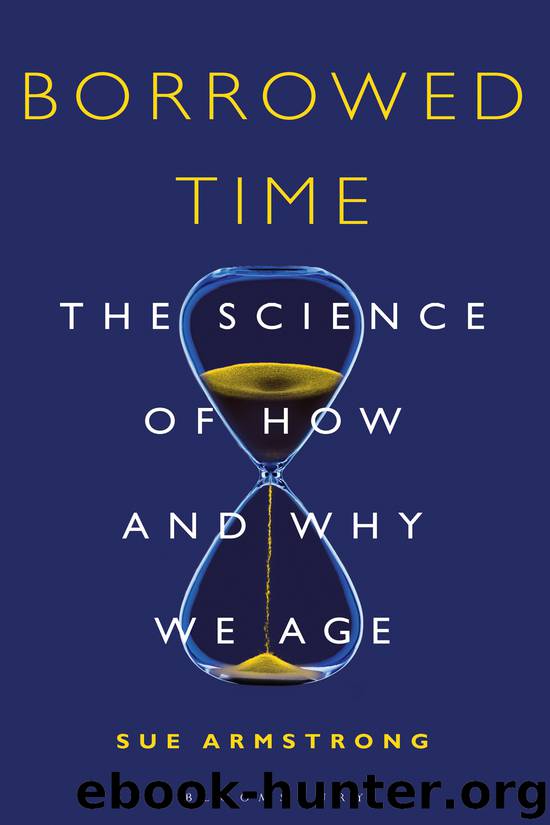Borrowed Time by Sue Armstrong

Author:Sue Armstrong
Language: eng
Format: epub
Publisher: Bloomsbury Publishing
CHAPTER THIRTEEN
Epigenetics and chronology – the two faces of time
What exactly do we mean by ‘premature ageing’? Except in extreme circumstances, this is a hard concept to grasp, for once people reach maturity it becomes increasingly difficult to judge accurately, just by looking at them, how old they are as they become weathered by their own unique experiences of living. So the question is, does our biology continue to keep step systematically with our chronology once the developmental programme has run its course? If so, is it played out at the level of the individual cells, or the tissues, or our bodies as a whole? And how predictable is it?
For some fascinating insights, let's take a look at epigenetics – one of the newest frontiers in ageing research. Epigenetics means ‘beyond the genes’, and it refers to the chemical switches attached to our DNA that orchestrate the activity of our genes, turning them on and off as appropriate, and modifying their tone. In common with all living organisms, we humans have a basic epigenome – an ‘instruction manual’ that controls the function of the genes so that a huge variety of different cell types can be fashioned from identical dollops of DNA, acquired when sperm and egg first met at the dawn of our lives, and present in every cell.
But that's not all. The epigenome is also the ‘missing link’ between our genes and our environment, since the basic manual can be edited throughout life by the addition or removal of chemical switches in response to a wide variety of cues. This mechanism enables organisms, including us, to adapt swiftly and perhaps transiently to environmental conditions without any changes to our basic DNA – in other words, without waiting for the ineffably slow process of natural selection to fit us more fundamentally to our world.
Take a look at these striking examples from Nature. There's a species of locust that develops without functional wings if there is likely to be lots of food and little competition in the world into which it's hatching. But if the signals it receives in the egg suggest high population density and lots of competition, it will develop wings that can carry it far afield to forage. The two bodily designs have identical genes, but they look so different that for a long time biologists believed they were separate species. The same mechanism is at work in honeybees, which decide when they are still larvae whether to develop into a queen or a worker bee, based on population dynamics and predictions about the role they'll play in the colony. And there's a species of meadow vole that is born with a thicker coat in winter than summer, indicating subtle, environmentally sensitive differences in how the genes are played, as orchestrated by the epigenome.
Here, in essence, is how the mechanism works. Structurally, DNA is an ultra-fine ribbon of continuous genetic material arranged in the famous corkscrew shape, the ‘double helix’, discovered by James Watson and Francis Crick in 1953 based on the images provided by Rosalind Franklin.
Download
This site does not store any files on its server. We only index and link to content provided by other sites. Please contact the content providers to delete copyright contents if any and email us, we'll remove relevant links or contents immediately.
| Cell Biology | Developmental Biology |
| Entomology | Marine Biology |
| Microbiology | Molecular Biology |
| Biostatistics |
Sapiens: A Brief History of Humankind by Yuval Noah Harari(14312)
The Tidewater Tales by John Barth(12625)
Mastermind: How to Think Like Sherlock Holmes by Maria Konnikova(7275)
Do No Harm Stories of Life, Death and Brain Surgery by Henry Marsh(6904)
The Thirst by Nesbo Jo(6877)
Why We Sleep: Unlocking the Power of Sleep and Dreams by Matthew Walker(6651)
Life 3.0: Being Human in the Age of Artificial Intelligence by Tegmark Max(5506)
Sapiens by Yuval Noah Harari(5321)
The Longevity Diet by Valter Longo(5039)
The Body: A Guide for Occupants by Bill Bryson(5027)
The Rules Do Not Apply by Ariel Levy(4907)
The Immortal Life of Henrietta Lacks by Rebecca Skloot(4548)
Animal Frequency by Melissa Alvarez(4424)
Why We Sleep by Matthew Walker(4394)
The Hacking of the American Mind by Robert H. Lustig(4336)
Yoga Anatomy by Kaminoff Leslie(4331)
All Creatures Great and Small by James Herriot(4267)
Double Down (Diary of a Wimpy Kid Book 11) by Jeff Kinney(4240)
Embedded Programming with Modern C++ Cookbook by Igor Viarheichyk(4137)
